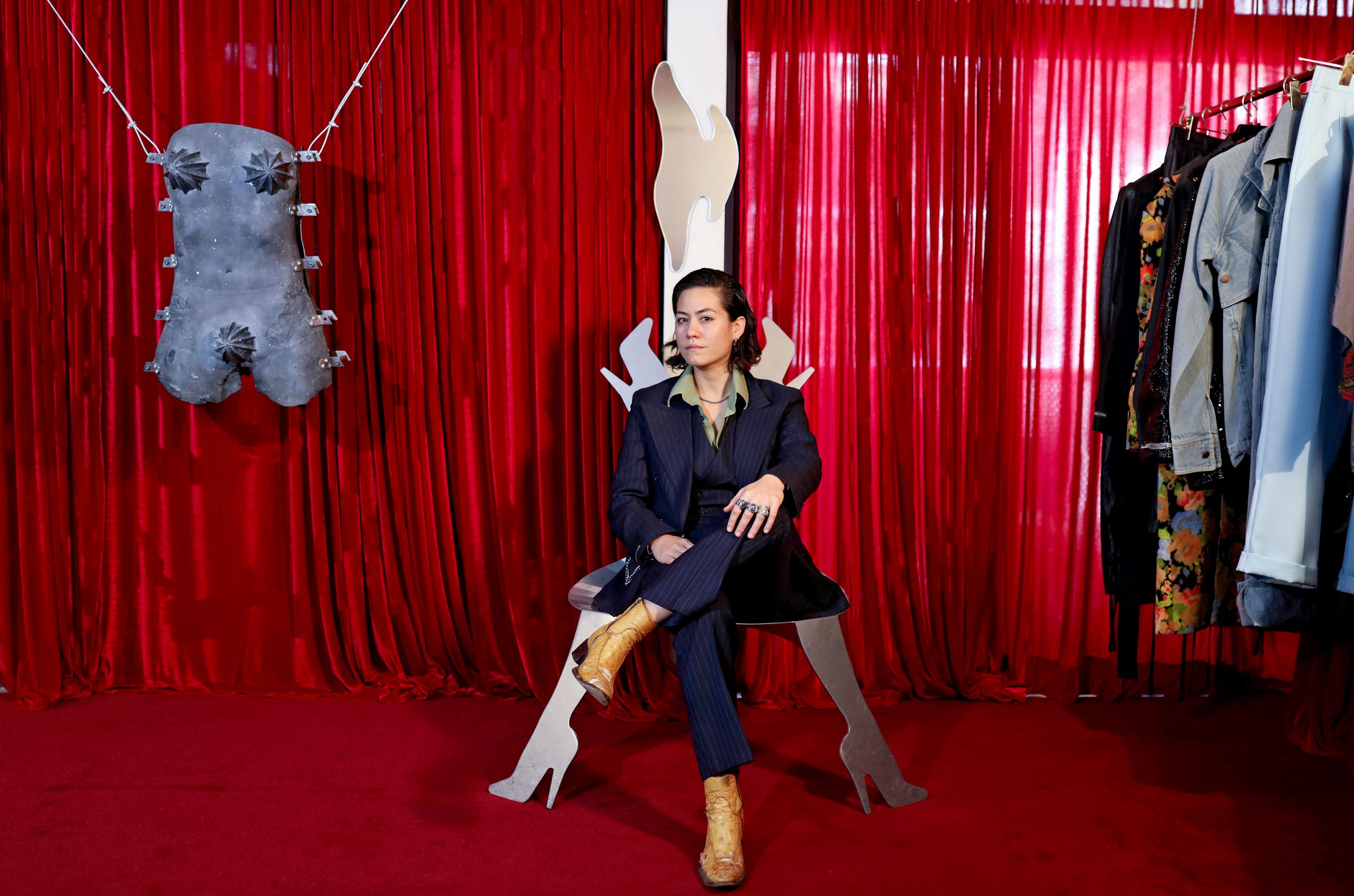
Bárbara Sánchez-Kane revels in the kind of artful provocation that comes from appropriating and dismantling prescribed notions of gender roles, dress codes, and beauty standards. The Mexican artist and fashion designer takes every opportunity to skewer patriarchal norms, riffing on the “collapse”—a word she often uses—of traditional gender expression in the pursuit of radical self-invention. That Sánchez-Kane prefers the pronouns ‘she’ and ‘he’—used interchangeably—is likely a provocation itself. Why not?
If Marcel Duchamp’s ironic readymades come to mind, or the Surrealist objects of Meret Oppenheim, or the conceptual fashion collections of Martin Margiela, or the clothing-cum-furniture of Hussein Chalayan—whom Sánchez-Kane cites as inspiration—you’re on the right track.
Bárbara Sánchez-Kane. Courtesy of Kurimanzutto.
Sánchez-Kane has been mining this wink-nudge terrain since at least 2016, when she founded her eponymous clothing line that blows past antiquated terms like ‘non-binary’ and ‘unisex.’ Of late, Sánchez-Kane has been moving more into the art zone, showing his sartorially based, queer-inflected artworks at Kurimanzutto gallery in Mexico City. There, whether through fashion, installation, sculpture, painting, performance, or poetry, the artist resists hegemonic masculinity in all its guises. The resulting objects invite interpretation, but conform to none. She refers to them as “art and confection” and they’re now on display in her first-ever New York solo exhibition, “New Lexicons for Embodiment,” at Kurimanzutto in Chelsea, which opens today and runs through October 21.
Sánchez-Kane has made a name for himself as an outlier in fashion with deconstructed Catholic school uniforms, conceptualized cowboy gear, and army fatigues exposing red lingerie in the rear. Recent experiments in masculine-feminine juxtaposition include a corset made of vinyl boxing gloves; shirts made of stiff rawhide; and boot spurs with a spinning wheel of high-heeled legs (the brand’s logo), like something from a dizzy mudflap. Bjork recently performed in a blue ‘calla lily’ hat by Sánchez-Kane, crowning the singer’s head like a Mayan headdress jeujed into a mulleted bouffant.
Boot spurs by Bárbara Sánchez-Kane. Via Instagram.
On a gallery visit leading up to the opening night (September 14), Sánchez-Kane was busily preparing for what amounts to a fashion happening—that is, staged at a gallery and sans runway. “It’s like a reconstruction of a fashion show, with what looks like a backstage but at the front of the gallery,” he explained, looking impishly chic in a casual tux jacket and chunky silver rings. It is a staged tableau vivant intended to befuddle guests before beguiling them. “Guests might even wonder if they’re permitted to come inside.”
Bárbara Sánchez-Kane, untitled (2023). Courtesy of Kurimanzutto.
In the stateside debut—an anti-fashion show during New York Fashion Week—Sánchez-Kane offers a fresh visual vocabulary in a series of new works at the intersection of art and fashion, where functionality is rejiggered into enigmatic, irreverent forms. Deconstruction followed by reconstruction followed by more deconstruction, there is a perpetual regeneration in these pieces, such as solid-bronze pumps with a reclining Christ as the sole. (The artist is sure she’ll get an earful from her devout mother for the droll foray into footwear blasphemy.)
Bárbara Sánchez-Kane, untitled (2023). Belts, rivets, polyester and metal. Courtesy of Kurimanzutto Gallery.
The artist buzzed about the space amid the hum and occasional thud of construction work, darting from one sculpture to the next, most of them already installed on the gallery’s walls and plinths. At the front of the show hangs a sculpture of interlacing belts that can be pulled to form a bow—“a girl thing,” mused the artist, “but giving the materiality an active rather than a passive role.” Several amorphous aluminum sculptures—created as a reaction to dress forms, used in the industry to calculate body types—loom in the back.
Flip flops as trowels. Courtesy of Kurimanzutto.
Shoes are of special interest to Sánchez-Kane; several pairs turn up in the show. Loafers have been fastened at the tongue like a coin purse or adorned in the front with two real Mexican coins, slightly bent to match the foot’s curve. Elsewhere, metal flip flops have been fashioned out of trowels (and suitably rest upon a cinderblock). “I was an engineer before I studied fashion,” she said, explaining that she built houses in Yucatán, where she was born and raised. “All of us working on the houses were wearing flip flops because it was so hot.”
Some objects lean into humor, even schadenfreude, such as a heavy leather suit pressed into the undulating shape of an egg carton. The artist had placed a smiling metal egg in one of the slots. Another heavy suit is partially made from clear plastic and will be worn by a live model at the opening. “It’ll definitely be warm and sweaty inside,” she predicted. The exhibition will also serve as a boutique where visitors can buy items from the very collection the gallery has on show, ranging from accessories to full looks. It’s difficult to know where art meets fashion meets commerce—and that is precisely the point.
Egg carton-shaped military uniform in green lambskin leather. Courtesy of Kurimanzutto.
Though Sánchez-Kane has been fairly disillusioned by the fashion industry, he hasn’t walked away from it altogether. It’s just that he no longer identifies with certain dynamics that strike him as dated or démodé, such as the standardization of body sizes, the superficiality of trends, the toxicity of fast fashion, the crassness of mass consumption. “The fashion system was not working for me,” she said, “but I’m still trying to find new ways to confront the body.”
“New Lexicons for Embodiment” by Bárbara Sánchez-Kane runs from September 14 to October 21 at Kurimanzutto, 520 W. 20th Street, New York.